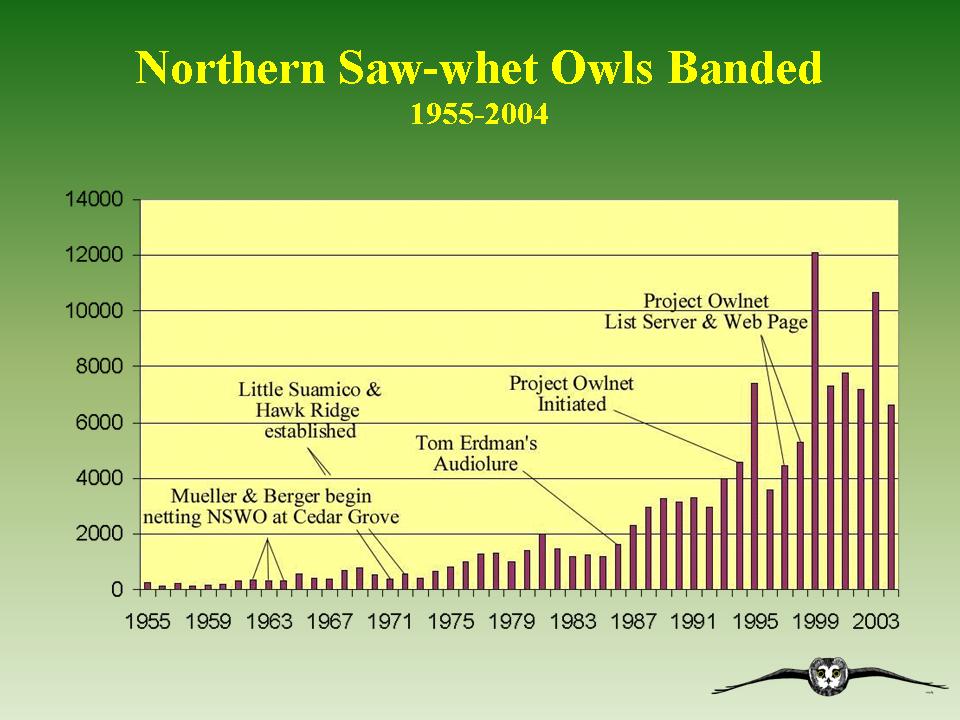History of Saw-whet Migration Research
“From the middle to the end of October the Saw-whet Owls migrate in considerable numbers,
but from their nocturnal habits and secluded habitats while en route are seldom observed.”
P.A. Taverner and B.H. Swales – The Auk, 1911
Because they are highly nocturnal, rarely vocalize outside the breeding season and are extremely hard to detect in daytime, the presence of large numbers of migrant saw-whet owls in the autumn was overlooked for centuries. Even after evidence began to surface in the early 1900s that this species is a regular migrant in North America, it was another 60 years before its migration was widely accepted.
In the early 1800s, Alexander Wilson referred to the saw-whet owl as “a general and constant inhabitant of the Middle and Northern States,” (Brewer 1840) while Audubon believed it was a resident breeder as far south as Louisiana (Ford 1957). Coues, Bendire and other late nineteenth-century ornithologists, while by then holding a more accurate view of the saw-whet owl’s breeding range, considered it either resident or at best weakly migratory at its northern limits (Coues 1874, Bendire 1892).
That assessment began to change in the early twentieth century, with reports from Lake Huron that a steamer boat captain experienced a fallout of “small owls” in the fall of 1903, and in October 1906, when an early snowstorm forced huge numbers of exhausted migrants to the water, where they drowned. Among the 1,845 birds counted by Saunders (1907) were 24 dead Northern Saw-whet Owls, whose presence he called “a surprise… Evidently they migrate in considerable numbers.”
Around the same time, ornithologists noted that saw-whets could be found commonly in autumn at Point Pelee and Long Point in Lake Erie, and concluded that “from the middle to the end of October the Saw-whet Owls migrate in considerable numbers, but from their nocturnal habits and secluded habitats while en route are seldom observed” (Taverner and Swales 1911). Not everyone was convinced, however. In 1938, Bent said only that the saw-whet owl “evidently migrates to some extent, or at least wanders widely, in fall” (Bent 1938), and a number of authors through the 1950s and 1960s continued to list the saw-whet owl as a permanent resident in regions like the upper Midwest (Wood 1951, Gromme 1963).
In the 1960s, Mueller and Berger (1967) at the Cedar Grove Ornithological Station in southern Wisconsin finally settled the question of migration status, showing that predictable numbers of saw-whet owls could be netted at night, even though the species was never detected there during the day, and vocalizations were never heard. The autumn of 1965 also marked what may still rank as the largest irruption of saw-whet owls ever recorded, with encounters as far south as Florida (Lesser and Stickley 1967). In the early 1970s, other banding sites in the upper Midwest followed Cedar Grove’s lead. After 15 years of traditional mist netting for migrant owls, in 1986, Tom Erdman of Little Suamico Ornithological Station north of Green Bay, Wisconsin began using a tape-recording of the male saw-whet’s advertising “toot” call, and experienced a more than 10-fold increase in the number of saw-whet owls caught versus passive netting (Erdman and Brinker 1997).
This audiolure technique spread to other saw-whet owl banding stations, with similar results, and researchers began to employ it in the East – at Cape May, N.J., where passive netting had begun in 1980, and where introduction of an audiolure in 1989 caused a six-fold rise in capture rates (Duffy and Kerlinger 1992, Duffy and Matheny 1997), and at Finzel Swamp, MD, where capture rates rose nearly four-fold (Erdman and Brinker 1997).
Interest in saw-whet owl banding increased in the southern mid-Atlantic region in the early 1990s, with stations opening on Sandy Point, MD, in 1990; Assateague Island, MD, in 1991; Casselman River, MD, in 1992; and Cape Charles, VA, in 1994 (Brinker et al 1997). At the time, saw-whet owls were generally considered rare or at best uncommon migrants to the region (Robbins and Van Velzen 1968).
The first well-documented irruption of saw-whet owls in 1995, however, changed that perception. The five sites operating in Maryland, New Jersey and Virginia accounted for an astounding 35% of the more than 7,400 saw-whet owls banded in North America that autumn. Cape May, which the previous year had netted 73 saw-whet owls, captured 637; Cape Charles, which caught 52 in 1994, banded 1,007 in 1995 (Brinker et al, 1997). In all, the five mid-Atlantic sites reported 2,596 of these “rare” owls. (Brinker et al 1997)
Just prior to the 1995 irruption, Dave Brinker, an ecologist with the Maryland Department of Natural Resources who, beginning in Wisconsin, had studied saw-whet owls for 20 years, conceived the idea of a collaborative network. Project Owlnet, which was based on Operation Recovery, the landbird banding effort of the 1960s, grew from a series of five cooperating saw-whet stations in Maryland, including one operated by Steve Huy, and from discussions with colleagues in Wisconsin.
Soon, sites in Maine, Massachusetts, Rhode Island, West Virginia, North Carolina and Cape Charles, VA were added. In 1997, a network of stations was established in Pennsylvania, and many of the existing Great Lakes and Canadian sites joined. The SAWWHETNET listserve began operation in 1998, and the irruption of 1999 prompted the founding of many more sites. By 2010, the Owlnet umbrella included more than 300 researchers representing more than 100 banding stations in Canada and the U.S., with a growing presence in the poorly studied intermountain West, coastal ranges and Alaska, western Canada, and the American Southeast. While saw-whet owl migration remains a primary focus, participants increasingly explore the movements of other species, including Boreal and Long-eared owls.
(Adapted from S. Weidensaul, “Migration and wintering ecology of northern saw-whet owls” in Pennsylvania Studies in Avian Ecology and Conservation, Majumdar et al, eds. Pennsylvania Academy of Science, 2010.)

